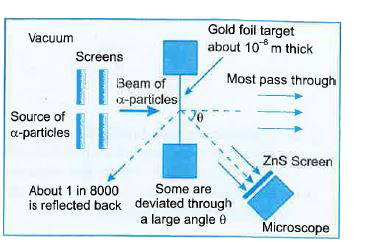Draw a schematic arrangement of the Geiger-Marsden experiment. How did the scattering of a-particles by a thin foil of gold provide an important way to determine an upper limit on the size of the nucleus ? Explain briefly.
A schematic arrangement of the Geiger-Marsden experiment is shown in Fig. 12.11.
In their experiment it was observed that most of the alpha-particles pass through the gold foil without any appreciable deflection. Some a particles are scattered through different angles and a very small number of particles suffers large angle scattering of about 180∘
Large angle scattering can be explained if we consider the entire positive charge and almost whole mass of gold foil atom to be concentrated in a tiny central core of the atom. When an α-particle with kinetic energy K approaches the gold nucleus directly along its central line it slows down, as it approaches the a-particles gold nucleus, due to coulombian repulsion force between nucleus and α-particle. The α -particle can come up to a certain minimum distance is called the distance of closed approach . Obviously value of distance of closest approach provides the upper limit on the size of the nucleus .

Topper's Solved these Questions
- BOOK - U-LIKE SERIESCHAPTER - ATOMSEXERCISE - LONG ANSWER QUESTIONS - II4videos
ATOMS
- BOOK - U-LIKE SERIESCHAPTER - ATOMSEXERCISE - SELF ASSESSMENT TEST (SECTION A( MULTIPLE CHOICE QUESTIONS))5videos
ATOMS
- BOOK - U-LIKE SERIESCHAPTER - ATOMSEXERCISE - SHORT ANSWER QUESTIONS30videos
ATOMS
- BOOK - U-LIKE SERIESCHAPTER - ALTERNATING CURRENT EXERCISE - SELF ASSESSMENT TEST (SECTION -C)2videos
ALTERNATING CURRENT
- BOOK - U-LIKE SERIESCHAPTER - CBSE EXAMINATION PAPER 2020 EXERCISE - SECTION D12videos
CBSE EXAMINATION PAPER 2020
Similar Questions
Draw a schematic arrangement of the Geiger Marsden experiment. How did the scattering of α particles by a thin foil of gold provide an important way to determine an upper limit on the size of nucleus? Explain briefly.
View SolutionDraw a schematic arrangement of the Geiger Marsden experiment. How did the scattering of α particles by a thin foil of gold provide an important way to determine an upper limit on the size of nucleus? Explain briefly.
View Solution
Knowledge Check
- Question 1 - Select One
In Geiger-Marsden experiment, it can be fairly assumed that the gold nucleus remains stationary throughout the scattering process as
Agold foild is very thinBα-particles are moving very fastCα-particles carry positive chargeDgold nucleus is about 50 times heavier then α-particles - Question 2 - Select One
In Geiger marsden experiment in a head on collision between an α particles and a gold nucleus the minimum separation is 4×10−14 m . the energy of α particle is
A5.68meVB8meVC4.47meVD7.24meV - Question 3 - Select One
In a geiger - marsden experiment. Find the distance of closest approach to the nucleus of a 7.7 me v α- particle before it comes momentarily to rest and reverses its direction. (z for gold nucleus = 79) .
A30 fmB20 fmC40 fmD10 fm
Draw a schematic arrangement of Geiger-Marsden experiment showing the scattering of C-particles by a thin foil of gold. Why is it that most of the O-particles go right through the foil and only a small fraction gets scattered at large angles ?
View SolutionIn the study of Geiger-Marsden experiment on scattering of alpha particles by a thin foil of gold, draw the trajectory of alpha-particles in the coulomb field of target nucleus, Explain briefly how one gets the information on the size of the nucleus from this study.
View SolutionIn the study of Geiger-Marsdon experiment on scattering of a-particles by a thin foil of ... trajectory of α-particles in the coulomb field of target nucleus. Explain briefly how one gets the … on the size of the nucleus from this study.
From the relation R=R0A1/3, where R0 is constant and A is the mass number of the nucleus, nuclear matter density is independent of A.View SolutionRead the following passage and then answer questions (a) - (e) on the basis of your understanding of the passage and the related studied concepts.
Rutherford was the pioneer who established the existence of the atomic nucleus. Result of Geiger and Marsden experiment on the scattering of a-particles from thin gold foils, performed at Rutherford’s suggestion, revealed that the distance of closest approach to a gold nucleus of an a-particle of kinetic energy 5.5 MeV is about 4.0×10−14m. The said scattering effect was explained by Rutherford by assuming that the Coulombian repulsive force was solely responsible for scattering. Since the positive charge is confined to the nucleus, the actual size of the nucleus has to be less than 4.0×10−14m.
If we use a-particles of higher energies, the distance of closest approach to the gold nucleus will be still smaller. At some point the scattering will begin to be affected by the short range nuclear forces and differ from Rutherford’s calculations. From the distance at which deviations set it, nuclear size can be inferred.
(a) Define MeV and express its value in terms of SI unit of energy.
(b) What is distance of closest approach ?
(c) Write an expression for distance of closest approach of a-particle to a gold nucleus.
(d) What was Rutherford’s hypothesis regarding the existence of the atomic nucleus ?
(e) How can you show that volume of the nucleus of an element is proportional to its mass number ?View SolutionIn a geiger - marsden experiment. Find the distance of closest approach to the nucleus of a 7.7 me v α- particle before it comes momentarily to rest and reverses its direction. (z for gold nucleus = 79) .
View Solution

